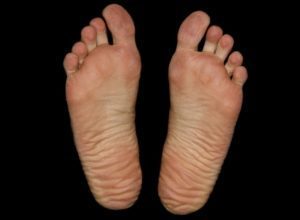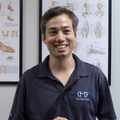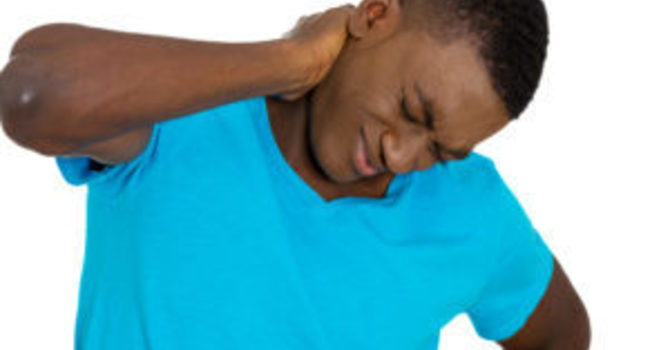
What is Plantar Fasciitis?:
It is pain associated with the plantar fascia of the sole of the foot, especially by the heel. Plantar fasciitis is the most common reason for pain on the plantar side (sole side) of the foot by the heel. It is commonly thought of as an inflammation of your plantar fascia, a thick fibrous band at the bottom of your foot similar to the thick band of tissue that makes up the palm of the hand. However, most cases of plantar fasciitis have no inflammation present and the pain is actually caused by the wear and tear, overuse, and eventual degeneration of the plantar fascia.
How Does Plantar Fasciitis Occur?:
It occurs from increased and prolonged tension on the plantar fascia.
What’s The Most Common Presenting Symptom of Plantar Fasciitis?:
Sharp pain at the bottom of the foot and heel after the first few steps when getting out of bed in the morning or after a period of prolonged sitting.
Risk Factors for Plantar Fasciitis:
- Pes planus (flat feet) (#1 mechanical reason for plantar fasciitis)
- Imbalances of the calf musculature and achilles tendon
- Imbalances of the 4 layers of muscle that make up the sole of the foot
- Imbalances of the hamstrings
- Poor footwear
- Job tasks or activities that require excessive standing, walking, or running.
- > 40 years of age
- Pes cavus (high rigid arches)
- Rapid weight gain/Obesity
Progress of Plantar Fasciitis:
Plantar Fasciitis starts with pain only within the first few steps taken after sleeping or resting but then it progresses to pain with every step and can continue for weeks months and even years if allowed to become chronic.
Prognosis of Plantar Fasciitis:
It’s easiest to treat at its initial inception and responds well to conservative hands-on treatments. If allowed to become chronic before seeking care, worse outcomes may occur.
Diagnosis of Plantar Fasciitis:
A detailed history and physical examination is sufficient for a diagnosis of plantar fasciitis in most cases. X-rays and advanced imaging are not often required and adds little value to care and management.
Treatment of Plantar Fasciitis:
Tissue-specific, hands-on treatment is the favored conservative treatment over anti-inflammatory medications. This is because most ongoing cases of plantar fasciitis show little to no inflammation in the tissue, but instead overuse/wear and tear of the tissue. It is also important, when possible, to address the risk factors mentioned above. In chronic cases, the plantar fascia may have to be immobilized at times in a lengthened position, through the use of a night splint.
Note: In a study published in 2012, Dr. DiGiovanni found that almost 2/3rds of the orthopedic foot and ankle surgeons surveyed preferred tissue-specific manual treatments, like the kind we provide here at the Center for Musculoskeletal Function, over cortisone injections and anti-inflammatory medications for the treatment of chronic plantar fasciitis cases (DiGiovanni et. al).
References
Alvarez-Nemegyei, J., and J. J. Canoso. “Heel pain: diagnosis and treatment, step by step.” Cleveland Clinic Journal of Medicine 73.5 (2006): 465-71. Web.
Digiovanni, Benedict F., Andrew M. Moore, Jason P. Zlotnicki, and Stephen J. Pinney. “Preferred Management of Recalcitrant Plantar Fasciitis Among Orthopaedic Foot and Ankle Surgeons.” Foot & Ankle International 33.6 (2012): 507-12. Web.
Renan-Ordine, Rômulo, Francisco Alburquerque-Sendín, Daiana Priscila Rodrigues De Souza, Joshua A. Cleland, and César Fernández-De-Las-Peñas. “Effectiveness of Myofascial Trigger Point Manual Therapy Combined With a Self-Stretching Protocol for the Management of Plantar Heel Pain: A Randomized Controlled Trial.” Journal of Orthopaedic & Sports Physical Therapy 41.2 (2011): 43-50. Web.
Santos, Bruno Dos, Leticia Amaral Corrêa, Luciano Teixeira Santos, Ney Armando Meziat Filho, Thiago Lemos, and Leandro Alberto Calazans Nogueira. “Combination of Hip Strengthening and Manipulative Therapy for the Treatment of Plantar Fasciitis: A Case Report.” Journal of Chiropractic Medicine 15.4 (2016): 310-13. Web.






